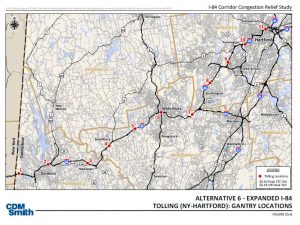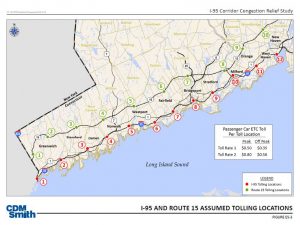CT DOT Proposed Tolling Locations Throughout Connecticut
Posted on June 6, 2017
The debate on tolls is now underway in the General Assembly, HB 6058.
The residents of Connecticut should be fully informed of all plans so that they can provide feedback to their elected officials as to their support or opposition on this issue.
The CT DOT has proposed installing tolls along major routes throughout Connecticut, including I-84, I-95, I-91, and Routes 2, 8, 9, and 11. The toll locations would not only be along the borders of our state, but also heavily scattered throughout.
Included below are two maps of CT Department of Transportation (DOT) proposed tolling locations along I-84 and I-95, in addition to the reports that detail the dynamic pricing (higher price during peak hours vs. lower price during non-peak hours).
The below report details plans and locations for toll booths on I-84 west of Hartford to New York.
This map shows proposed toll locations for I-84 West of Hartford.

CDM Smith was selected by the Connecticut Department of Transportation (CTDOT) to perform a congestion pricing study of the Interstate 84 Viaduct in Hartford under the Federal Highway Administration (FHWA) Value Pricing Pilot Program (VPPP).
This study included the assembly and collection of traffic and travel time data, a stated preference survey to estimate motorists’ value of time in the study corridor, and a detailed traffic modeling and toll revenue evaluation for pricing alternatives.
Full Executive Summary by Connecticut House Republicans on Scribd
The below report details plans and locations for toll booths on I-95 and the Merrit Parkway from New York line to New Haven.
This map shows proposed toll locations on I-95 from the New York border to New Haven.

CDM Smith (Project Team) was also selected by the Connecticut Department of Transportation (ConnDOT) to perform a corridor congestion relief study of Interstate 95 (I-95) and the Merritt Parkway (Route 15) from New Haven to the New York State Line …under the Federal Highway Administration (FHWA) Value Pricing Pilot Program (VPPP).
This study included the assembly and collection of traffic and travel time data, a stated preference survey to estimate value of time in the study corridors, and a detailed traffic modeling and toll revenue evaluation for a variety of configuration and pricing alternatives. In addition to the I-95 findings discussed in this executive summary, several other study documents have been submitted covering current Federal tolling laws, the state of tolling readiness in Connecticut, and Public-Private Partnership approaches used for tolling.
I-95 Corridor Congestion Relief Study – Executive Summary by Connecticut House Republicans on Scribd